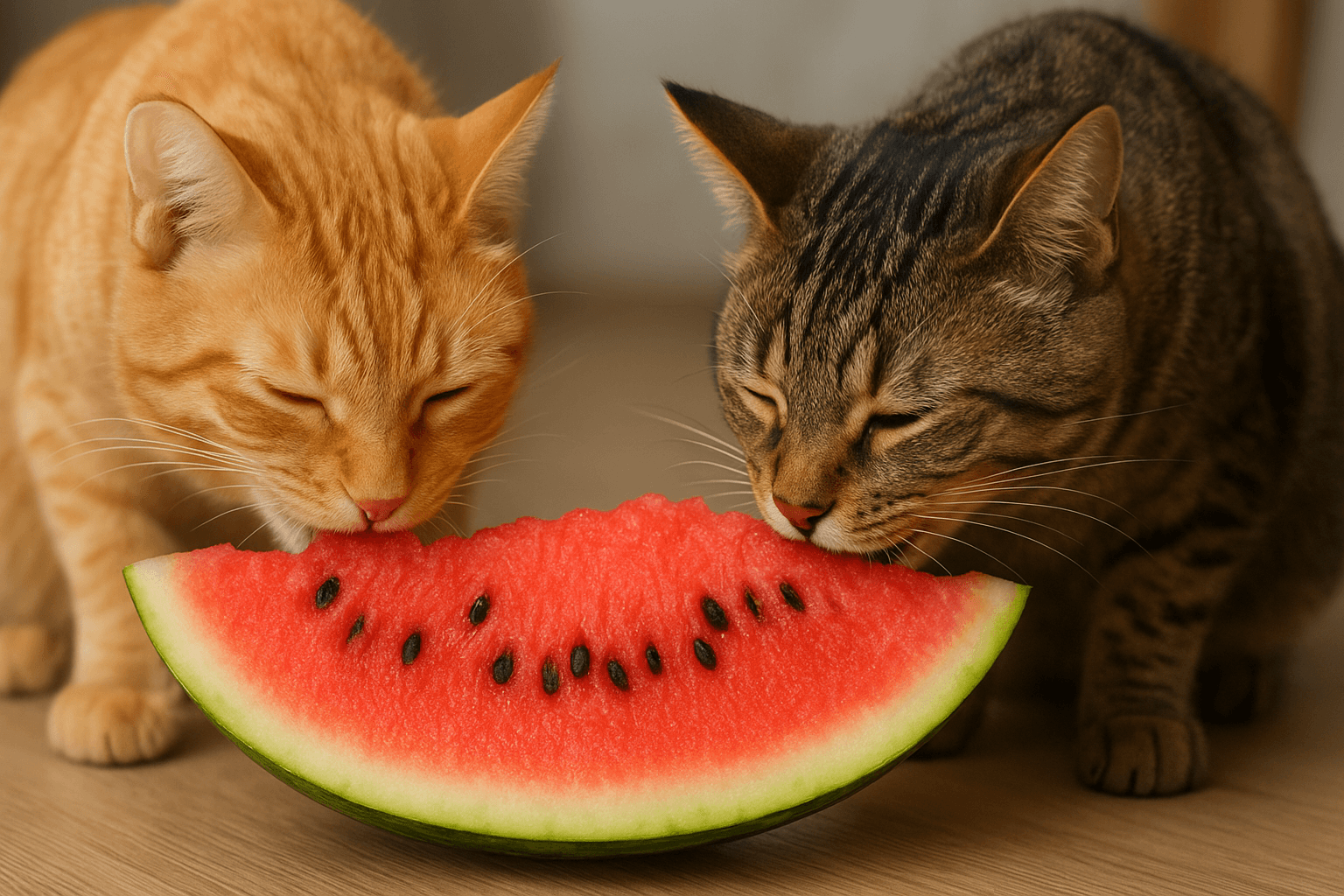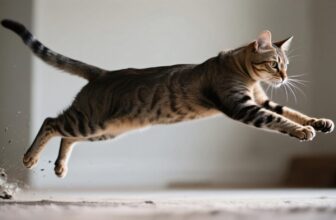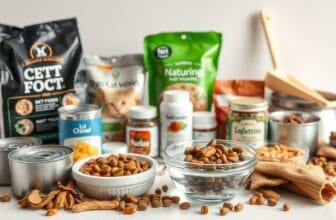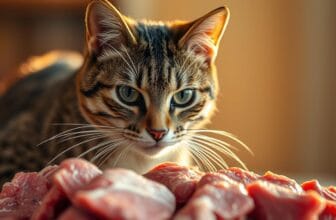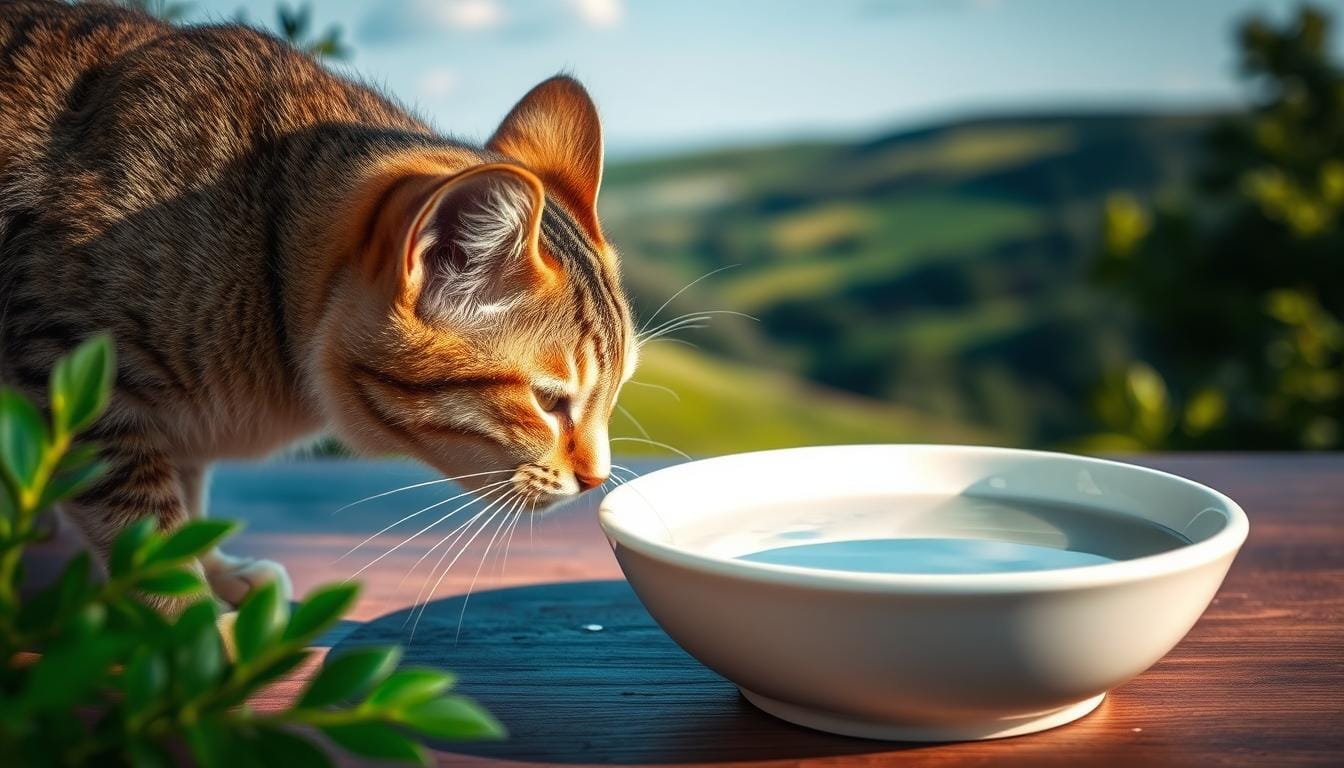
Table of Contents
Ever think if your cat drinks enough water? Keeping your cat hydrated is key to their health. It helps prevent many health issues.
It’s not just about filling a water bowl. Cats need the right amount of water, depending on their diet and health. This guide will help you keep your cat hydrated.
Cats don’t drink like dogs do. Their ancestors lived in the desert, so they have special ways to get water. They get moisture from food and natural drinking habits.
We’ll explore cat hydration in detail. You’ll learn how much water your cat needs and how to ensure they stay hydrated. This guide is for all cat owners, whether you have a kitten or an older cat.
Understanding the Importance of Water for Cats
Many pet owners don’t realize how important water is for their cats. Water is key to keeping your cat healthy and happy. It helps their body work right.
Your cat needs water for many important tasks. Knowing about cat hydration helps you take better care of your pet.
Essential Functions of Water in Feline Health
- Regulates body temperature
- Supports organ function
- Facilitates nutrient transportation
- Maintains electrolyte balance
The Role of Hydration in Body Systems
Water is vital for many body systems in cats. It helps with:
- Digestive processes: Helps break down food and absorb nutrients
- Circulatory system: Keeps blood flowing smoothly and delivers oxygen
- Urinary health: Keeps kidneys healthy and helps remove waste
Impact on Overall Cat Wellness
Good hydration affects your cat’s energy, metabolism, and health. A hydrated cat is more active, has better skin, and stays at a healthy weight.
Water is not just a drink—it’s a lifeline for your feline friend.
Daily Water Requirements for Cats
Keeping your cat hydrated is key to their health. Each cat’s water needs vary based on their weight, age, and health. Generally, cats need about 4 ounces of water for every five pounds of body weight each day.
Here are some tips to track your cat’s water intake:
- An average 10-pound cat needs about one cup of water daily
- Younger cats usually need more water than older cats
- More active cats might need extra water
Water isn’t the only way cats stay hydrated. They also get moisture from wet food and their body’s natural processes. Watching how much water your cat drinks can help avoid health problems.
Several things affect how much water a cat needs:
- Body weight
- Activity level
- Temperature of their environment
- Overall health
If you’re not sure about your cat’s water needs, talk to your vet. They can give advice tailored to your cat’s health and lifestyle.
How Cats Get Their Water Intake
Cat hydration is more than just drinking from a bowl. Your cat gets moisture from various sources. Each source is important for their health.
Cats have special ways to stay hydrated. Knowing these can help keep your cat healthy.
Water from Drinking
Drinking water is key for cats. They like fresh, clean water. Some cats prefer running water, which is why fountains are popular.
- Ceramic bowls prevent water from tasting metallic
- Wide, shallow bowls reduce whisker fatigue
- Multiple water stations encourage drinking
Moisture Content in Different Food Types
Your cat’s diet affects their hydration. Wet food is especially good for moisture.
| Food Type | Water Content | Hydration Impact |
|---|---|---|
| Wet Food | 70-80% | High hydration support |
| Dry Food | 10% | Limited hydration |
Natural Water Sources
Outdoor cats might find water in puddles, birdbaths, or on plants. While not recommended, it shows cats’ clever ways to find water.
Knowing how cats hydrate helps you support their health. It ensures they get enough water.
Signs of Proper Cat Hydration
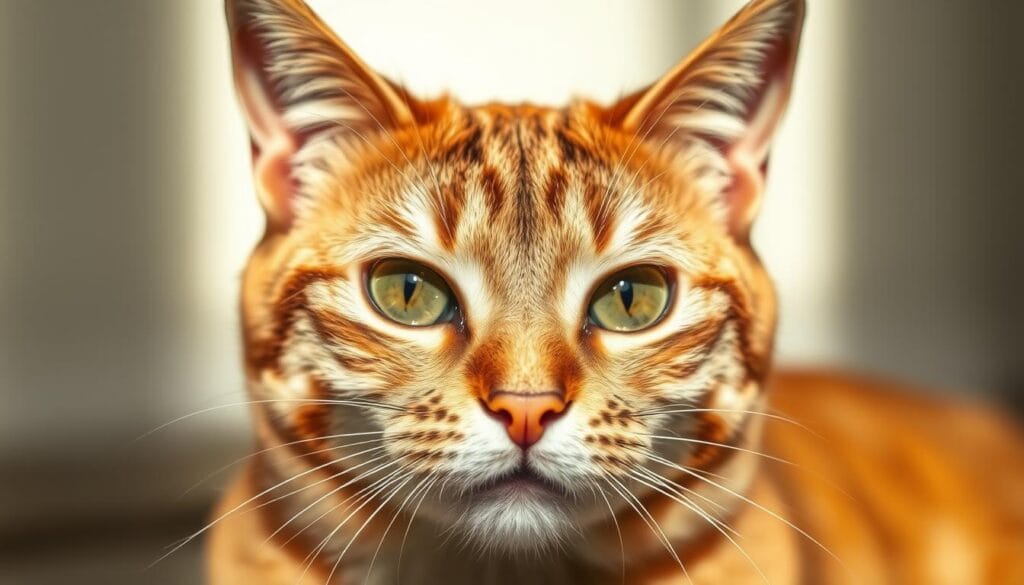
Knowing the signs of proper cat hydration is key to keeping your cat healthy. It’s not just about giving them water. Vets say there are important signs to look for to make sure your cat is hydrated and feeling good.
Here are the main physical signs to check:
- Skin Elasticity Test: Pinch the skin on your cat’s back. If it snap back right away, your cat is hydrated.
- Gum Appearance: Healthy cats have moist, pink gums. They should not feel sticky or dry.
- Urine Color: If your cat’s urine is light yellow to clear, they are drinking enough water.
Behavioral signs also matter. A hydrated cat is energetic, goes to the bathroom regularly, and eats well. If your cat seems tired, doesn’t want to drink, or eats less, they might be dehydrated.
Vets recommend watching how much water your cat drinks every day. A cat needs about 3.5 to 4.5 ounces of water for every 5 pounds of body weight. Cats eating wet food need less water than those on dry food.
“Watching your cat closely is important for their hydration,” says Dr. Emily Richardson, a cat nutrition expert.
By keeping an eye on your cat and taking them to the vet regularly, you can make sure they stay hydrated and healthy.
Recognizing Dehydration in Cats
Cat hydration is key to their health. Knowing the signs of dehydration early can stop serious problems. It keeps your cat healthy and happy.
Cats are good at hiding how they feel. Spotting dehydration signs early is crucial for their health.
Physical Symptoms of Dehydration
Look out for these important signs of dehydration in cats:
- Skin elasticity loss (pinch test)
- Dry, sticky gums
- Sunken eyes
- Decreased skin turgor
- Pale or whitish gum color
Behavioral Changes to Notice
Dehydration can also show in your cat’s behavior:
- Reduced activity levels
- Lethargy or weakness
- Decreased appetite
- Unusual sleeping patterns
- Reduced grooming
When Veterinary Intervention is Necessary
Call your vet right away if you see:
- Persistent symptoms lasting over 24 hours
- Extreme lethargy
- Complete loss of appetite
- Significant weight loss
- Continuous vomiting or diarrhea
Spotting dehydration early can prevent serious health issues and save your cat’s life.
Factors Affecting Cat Hydration
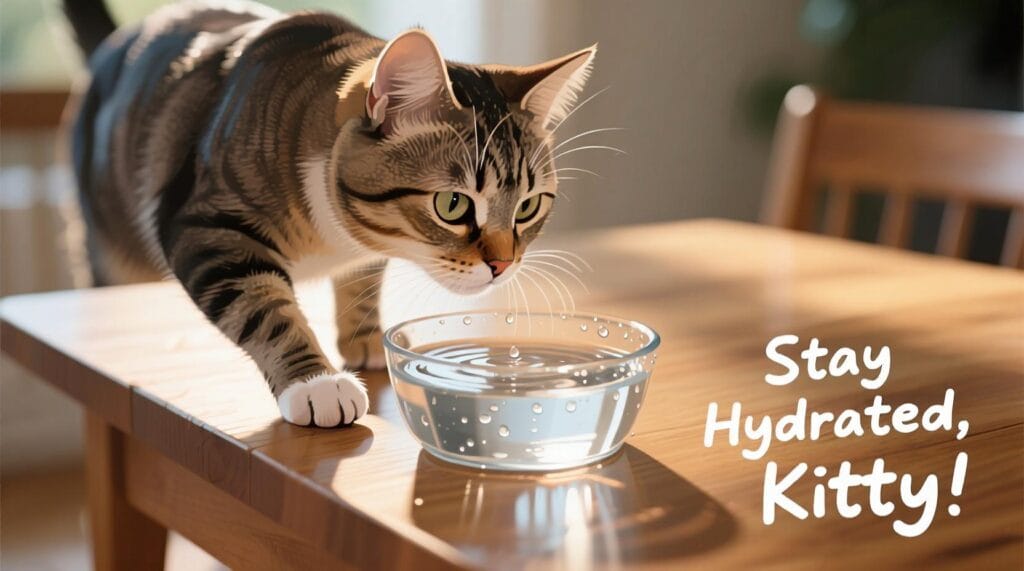
It’s important to know what affects your cat’s hydration. Many things can change how much water your cat drinks. This is key for keeping your cat healthy.
Where your cat lives affects how much water it needs. The weather, like hot summers, makes cats drink more. This helps them stay cool and avoid dehydration.
- Age-related changes impact cat hydration needs
- Health status determines water consumption patterns
- Activity levels influence daily water requirements
What your cat eats is also important. Wet food has a lot more moisture than dry kibble. Cats eating mostly dry food might need extra water to stay hydrated.
Behavior and social life can also affect your cat’s drinking. Stress or living with other cats can make it hard for them to drink enough. Cats might not want to drink if they’re stressed or if their home changes.
Proper cat hydration requires attentive monitoring and understanding of your individual cat’s unique needs.
Your cat’s likes and dislikes matter too. Some cats like running water from fountains, while others prefer wide, shallow bowls. Trying different ways to present water can help your cat drink more.
The Connection Between Diet and Water Intake
It’s important to know how your cat’s diet affects their hydration. Different cat foods can greatly influence how much water your pet drinks. Wet and dry foods have big differences in this area.
Your cat’s diet is key to their water intake. Since cats don’t naturally drink much, the moisture in their food is crucial. It helps them stay hydrated.
Wet Food vs. Dry Food Hydration Impact
- Wet food contains up to 80% moisture
- Dry food typically contains only 10% moisture
- Cats on dry food diets need to drink more water
Calculating Water Content in Cat Food
To keep your cat hydrated, check their food’s moisture level. Here’s a comparison of water content in various foods:
| Food Type | Moisture Percentage | Hydration Support |
|---|---|---|
| Canned Wet Food | 75-85% | High |
| Semi-Moist Food | 30-40% | Moderate |
| Dry Kibble | 5-10% | Low |
Choosing the right food for your cat can greatly affect their hydration. You might want to mix wet and dry foods. Or add water to dry kibble to boost moisture.
Common Causes of Increased Water Consumption

It can be hard to figure out why your cat drinks more water. Several things can make them drink more, from changes in their environment to health issues.
Some common reasons for increased water intake include:
- Hot weather conditions
- Increased physical activity
- Changes in diet
- Medication side effects
Medical conditions also affect how much water cats drink. Certain health problems can make them drink a lot more:
- Chronic Kidney Disease: Cats with this condition drink more because their kidneys can’t filter waste well
- Diabetes: Drinking more water is a common sign of diabetes in cats
- Hyperthyroidism: This condition can make cats drink more water due to metabolic changes
If you see your cat drinking a lot more water, watch them closely. Keeping track of how much water they drink can help spot health problems early. If your cat drinks a lot more water than usual, it’s a good idea to talk to a vet.
Remember, every cat is unique, and understanding their individual hydration needs is key to maintaining their health.
Medical Conditions Related to Cat Hydration
It’s important to know how cat hydration relates to health issues. Some diseases can really affect how much water your cat needs and their overall health.
Some health problems can make your cat drink more water or lose a lot of fluids. Spotting these issues early can help keep your cat hydrated.
Chronic Kidney Disease: A Major Hydration Challenge
Chronic kidney disease is a big problem for cat hydration. Cats with this disease may:
- Drink more water
- Go to the bathroom more often
- Have fluid imbalances
Diabetes and Hyperthyroidism: Fluid Dynamics Disrupted
Diabetes and hyperthyroidism can change how much water your cat drinks and how their body handles fluids. These conditions often make cats drink and urinate too much, leading to dehydration.
Additional Health Concerns Affecting Hydration
Other health issues can also affect cat hydration, including:
- Gastrointestinal problems
- Urinary tract infections
- Vomiting and diarrhea
Regular vet visits can catch these problems early. This helps manage your cat’s hydration needs.
Water Bowl Placement and Selection Tips
Choosing the right water bowl and where to put it can really help your cat drink more. Cats are very picky about where they drink. Even small changes can make a big difference.
When picking out water bowls, keep these tips in mind:
- Location matters: Place water bowls away from food and litter boxes
- Use wide, shallow bowls that prevent whisker fatigue
- Select ceramic or stainless steel materials over plastic
- Provide multiple water sources throughout your home
Your cat might like running water or still water. Try different bowls and spots to see what your cat prefers.
In homes with more than one cat, make sure each has its own water bowl. Put bowls in different rooms to avoid fights and stress.
A well-placed water bowl can be the key to encouraging better cat hydration habits.
Think about getting a pet water fountain. These make drinking water fun and exciting for cats. They keep the water fresh and moving, which cats love.
- Clean water bowls daily
- Refresh water frequently
- Monitor your cat’s water consumption
By focusing on where and what kind of water bowls you use, you can help your cat stay hydrated. This is good for their health overall.
Encouraging Healthy Drinking Habits
Keeping cats hydrated can be tough for many pet owners. Cats often drink very little water. So, finding creative ways to get them to drink is key for their health.
Here are some effective strategies to boost your cat’s water consumption:
- Install a cat water fountain to make drinking more appealing
- Place multiple water bowls around your home
- Use wide, shallow bowls that don’t touch whiskers
- Clean water bowls daily to ensure freshness
Water fountains can make a big difference. They provide moving water that many cats find more appealing. The flow mimics natural water sources, encouraging cats to drink more often.
“The key to successful cat hydration is making water interesting and accessible.” – Veterinary Hydration Experts
Some cats like their water with a bit of flavor. Try these safe options:
- Small amounts of tuna water
- Low-sodium chicken broth
- Ice cubes as a playful drinking incentive
Wet food is a big help in keeping your cat hydrated. Mixing wet and dry food or adding water to dry kibble can increase hydration.
Watch how your cat likes to drink and try different methods. Every cat is different. What works for one might not work for another in keeping them hydrated.
Monitoring Your Cat’s Water Consumption
It’s important to keep an eye on how much water your cat drinks. This helps keep them hydrated and can spot health problems early. Knowing how much your cat drinks can tell you a lot about their health.
Cats usually drink water 2-4 times a day. But, how much they drink can change based on their diet and lifestyle. Watching your cat’s water intake closely is key.
Daily Tracking Methods
- Measure water bowl levels before and after 24 hours
- Use dedicated water measuring cups
- Create a daily drinking log
- Observe frequency of water bowl visits
Recognizing Normal vs. Abnormal Patterns
What’s normal for a cat’s water intake depends on a few things:
- Diet type: Cats eating wet food drink less than those eating dry food
- Average daily water intake: 3.5-4.5 ounces per 5 pounds of body weight
- Consistent drinking times
Look out for signs that your cat might not be drinking enough, such as:
- Sudden increase or decrease in water consumption
- Dry gums
- Reduced skin elasticity
- Lethargy
By paying close attention to your cat’s water intake, you can help keep them healthy and hydrated.
Special Considerations for Multiple Cat Households
Dealing with cat hydration gets tricky when you have more than one cat at home. Their social lives and territorial behaviors can affect how much water they drink.
Cats are naturally territorial. In homes with multiple cats, getting to water can be a challenge. Some cats might take over the water, stopping others from drinking. This can cause hydration problems.
- Place multiple water stations throughout your home
- Ensure each cat has easy access to fresh water
- Use different types of water bowls to accommodate individual preferences
- Monitor each cat’s drinking habits
Putting water bowls in different spots can help avoid fights. Set up stations in various rooms, away from food and litter boxes. Spread out these stations to give each cat a sense of personal space.
Look out for signs of bullying or cats guarding water. If one cat stops another from drinking, you might need separate drinking spots or water fountains. This ensures all cats stay hydrated.
Creating a harmonious hydration environment is key to maintaining your cats’ health and happiness.
Keep an eye on how much water each cat drinks. Their needs can change based on age, weight, and health.
Conclusion
Knowing how to keep your cat hydrated is key to their health. We’ve looked at how to ensure your cat drinks enough water. This includes spotting when they need more and the dangers of dehydration.
As a cat owner, you play a big part in their hydration. By using tips like offering many water spots and watching their drinking, you can boost their health. This makes their life better and longer.
Hydration is more than just quenching thirst. It helps your cat’s body work right and keeps them healthy for a long time. Regular vet visits and watching how much they drink are important. They help avoid big health problems.
Every cat is different, so their water needs can change. Keep learning, watch your cat closely, and talk to vets if you’re worried. This helps keep your cat happy and healthy.
FAQ
How much water does a cat need daily?
Cats need about 3.5 to 4.5 ounces of water for every 5 pounds of body weight each day. This amount can change based on your cat’s diet, how active they are, and their health. Cats eating wet food get a lot of their water from their food. Those on dry food need to drink more water.
How can I tell if my cat is dehydrated?
Check for signs like skin that doesn’t bounce back quickly, dry or sticky gums, sunken eyes, and lethargy. Also, look for dark or less urine. If your cat’s skin doesn’t snap back, they might be dehydrated. Always talk to your vet if you think your cat is dehydrated.
Why don’t cats seem to drink much water?
Cats have a low thirst drive, a trait from their desert ancestors. They get most of their water from their food. Wet foods give cats up to 80% of their water, while dry foods only give about 10%. Vets often suggest adding wet food to their diet.
What can cause a cat to drink more water suddenly?
Several things can make a cat drink more water, like diabetes, kidney disease, or hyperthyroidism. Medications, hot weather, more activity, or changes in diet can also cause it. If your cat drinks more and it lasts, or if they have other symptoms, see your vet.
How can I encourage my cat to drink more water?
Use cat water fountains, which many cats like better than still water. Place several water bowls around your home, keep them clean, and away from food. Try adding ice cubes or using wide, shallow bowls. You can also give more wet food or add water to dry food.
Are some cats more prone to dehydration?
Yes, some cats are more at risk of dehydration. Senior cats, cats with health issues, those on dry food, and cats in hot places are more likely. Cats with kidney disease, diabetes, or on certain meds may need more water. Always watch your cat’s water intake and talk to your vet about their needs.
What type of water bowl is best for cats?
Cats like wide, shallow bowls that don’t touch their whiskers. Stainless steel or ceramic bowls are good because they’re easy to clean and don’t smell. Avoid plastic bowls because they can harbor bacteria and cause skin problems. Some cats prefer running water, so a cat fountain might be a good choice.



